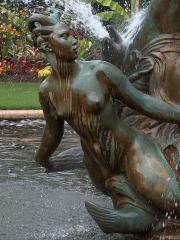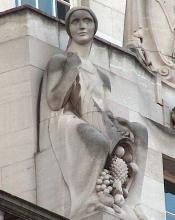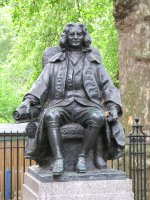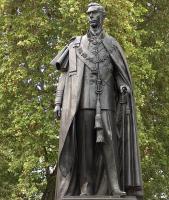William McMillan (1877-1977)
William McMillan: mermaid for Regent's Park Fountain.
The sculptor William McMillan has two familiar sculptural fountains in London, in Trafalgar Square and Regent's Park, and various other public sculpture, mostly from the 1950s, though his oeuvre stretches from pre-World War I through to the late 1960s. He was born in Aberdeen, but developed his craft and his style at the Royal College of Art in London, under the New Sculptor Edouard Lanteri. Following service in World War I in the Artists Rifles and the Light Infantry, he returned to sculpture after the war, and was elected Associate of the Royal Academy in 1925, full Academician in 1933, and from the end of the 1920s through till 1941 was Master of the Sculpture School at the Academy. His studio for most of his long professional life was in Chelsea, West London.
Most characteristic of William McMillan's sculpture are his ideal female nudes and draped figures. His style tends to the rather Art Deco, with smooth-featured figures with a minimum of detail in the drapery, where present, and softly rounded limbs, with the musculature hinted at rather than emphasised, columnar necks, and slightly elongate heads, almond-shaped from cheek to chin. Little detail to the hair either, unless, like the draperies, in a Flaxman-like simplicity, with the emphasis on perfection of proportion and pose rather than detail. A good example of this type is high up in Cornhill, pictured below.
Cornhill figure with cornucopia.
McMillan's best known works in this vein are his fountains noted above: one pair out of the four in Trafalgar Square, for the fountain at the eastern side (1948), and another grand group in the Goetze Memorial Fountain, with triton and mermaids, in Regent s Park (1950) - picture at top of page. They are in bronze, and the sleek surface of the sculpture suits the wetness and subject matter. In both fountains, the figures are the type of mermaid with a split tail: the Triton type, and the sense of strength and controlled energy is more than in McMillan s usual nudes. They are very beautiful. The Trafalgar Square groups also show McMillan's perfect renderings of dolphins and sharks.
So far as McMillan's portrait sculpture goes, I think the one I like best is his Captain Coram in Brunswick Square, by his hospital. See picture above (click to enlarge). The modern clothing - vast cloak over waistcoat and breeches tucked into his high boots - is still simple, but has a restless surface, as do the craggy features and claw-like hands. His statue of Turner in the Royal Academy has rather more folds in the drapes than usual for McMillan, and give a good sense of arrested movement; again, the face is craggy and characterful. His George V in Carlton Gardens just north of the Mall is more simple, more symmetrical, even more so in his other statues such as Hugh Oldham in Telford Road, Manchester.
George VI, Carlton Gardens.



